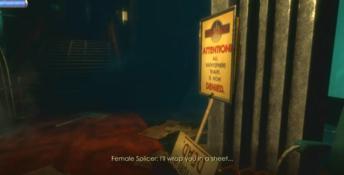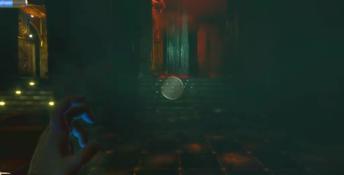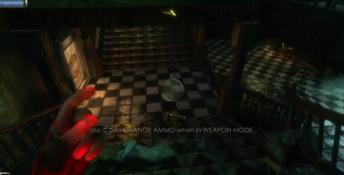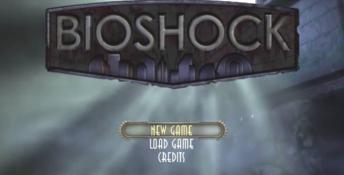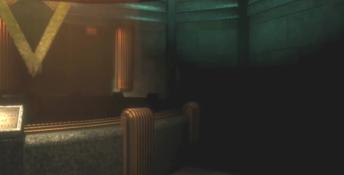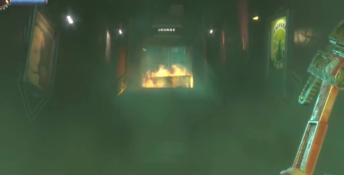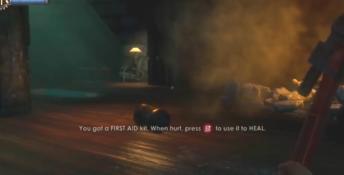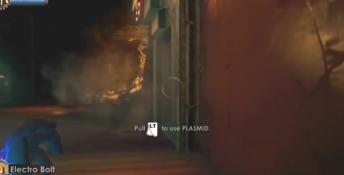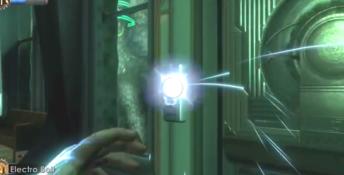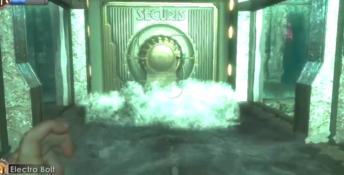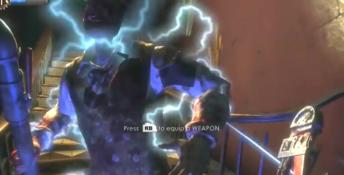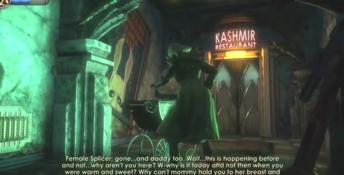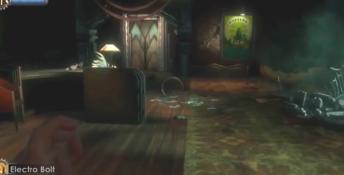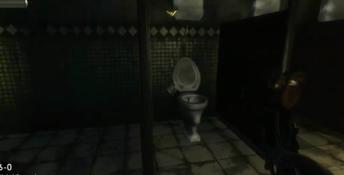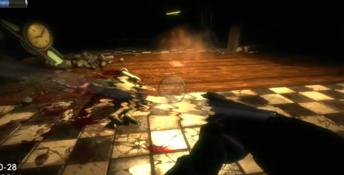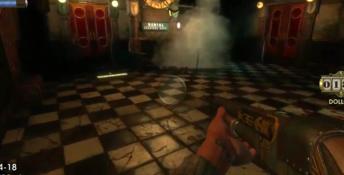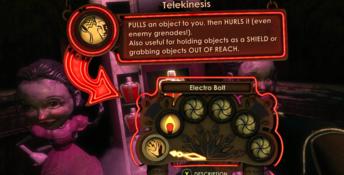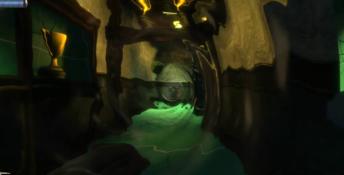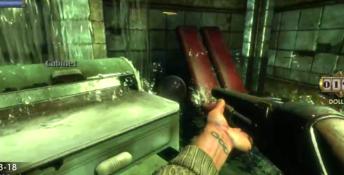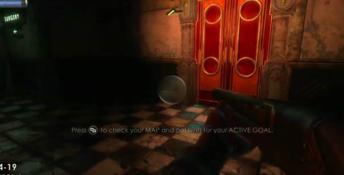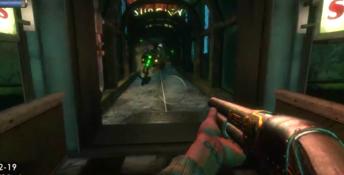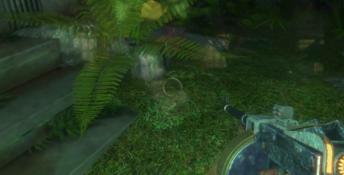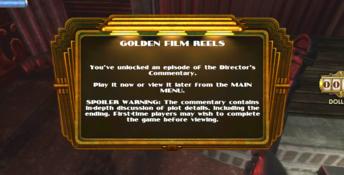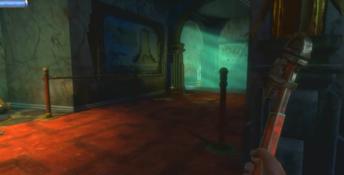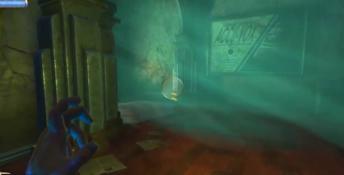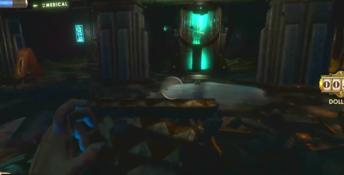BioShock
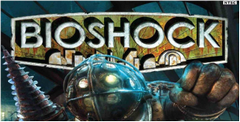
| a game by | 2K Boston, Inc, and 2K Australia Pty |
| Genre: | Action |
| Platforms: | XBox 360 (2007), XBox One, PC (2007), Playstation 3 (2008) |
| Editor Rating: | 8.5/10, based on 3 reviews, 6 reviews are shown |
| User Rating: | 9.6/10 - 5 votes |
| Rate this game: | |
| See also: | Tactical RPGs, Alternate History Games, Steampunk Games, Underwater Games, Games Like Dead by Daylight, Games Like Fallout 4, Bioshock Series |
"There's Nothing Like an immolated monster flailing around, screaming and setting nearby objects on fire in panic." Ken Levine, creative director of Irrational Games, loves his job. In an industry that often seems packed with cynical, ageing individuals who have lost their gaming mojo, Levine is a refreshingly enthusiastic and passionate developer. Having worked on such titles as Thief: The Dark Project and System Shock 2, the ex-Hollywood scriptwriter knows a thing or two about making a game that's fun to play, but also a darker, dare we say it, more 'mature' experience. BioShock could be Levine's greatest game yet - a frightening shooter set in a submerged art deco utopia called Rapture, once populated by the world's great minds, but now perverted into a diseased, deadly ecosystem where genetic mutation has spun wildly out of control.
"We wanted to build a place that said 'There's no easy escape'," begins Levine. "That's what always bothered me about a lot of shooters - the artificiality of it all. You think, j 'Why can't I just run that way and get out of; here? Because that car is in the way?' The | sad truth is that games are a bit of a fib. I want to make games that minimise the fib.
Whole Mistruth
What we've seen of BioShock is no lie -the last presentation in September showed an uncompromisingly brutal FPS, where you must use every aspect of the environment weapons and special 'Plasmid' bio-skills to negotiate the nightmarish underwater city. But how are Levine and his team going to introduce the player into this horrific reality and explain the detailed back-story of Rapture's demise?
"Well, I'm not a fan of the tutorial - we're trying to avoid tutorial-itis," laughs Levine. "The dynamic training system is our version of having a buddy who's already played the game sitting with you, giving you a nudge in the right direction if you get lost. As for the story, there's about a zillion ways we tell it.."
Show Don't Tell
Most obviously, BioShock is littered with visual clues, as no two places in Rapture promise to look the same. "We use a device called mise en scene': which loosely translates to Levine's a pretentious twit'. What it really means, if you're not a regular Late Review viewer, is that the developers set up visual scenes so you can, perhaps, identify what happened. For example, you might stumble upon a bedroom with the corpses of a man and woman on a bed, with a photo of a young woman between them, and several bottle of pills on the bedside table.
More disturbingly, you could find an audio log of a cop who was forced to murder someone, describing the apartment of the person he killed just before you discover the eerie location, complete with a ghost-like resonance of the victim's last moments.
Levine continues: "You could even encounter desperate survivors, wheeling and dealing with you for one last chance to make it out of the city. We've got no shortage of story-telling devices."
BioShock lias been describecras freeform', in the sense that the levels are fairly open and sprawling in comparison with your usual shooter. Plus, according to Levine, you can freely travel back to any area you've visited before.
"The traditional mission structure is used to prevent players from travelling to overly dangerous areas, but there might be cases where the player is like, 'This spot is too hot, I'm going back to build myself up a bit'."
This said, the game will be split into seven distinct areas (we'll call them levels, for simplicity's sake), and each will have its own themes and internal storylines beneath the vast canopy of the BioShock narrative arc. One, for example, is called Hephaestus (that's the Greek god of blacksmiths, technology and fire, fact fans), which deals with what fuels Rapture: extremely hot steam produced from volcanic vents that lie at the very bottom of Davy Jones' Locker.
Another, called Arcadia, is an environment that illustrates some of the practical problems of building an underwater city - it's a vast arboretum designed to provide oxygen for the city's population. Unfortunately, however, the powers that be have released something toxic into its vicinity - and it's up to you to stop the rot setting into the plant-life.
Twisted Sisters
Apart from obviously trying to escape the city, your character in BioShock can be motivated by other people in Rapture who guide you and give you tasks to accomplish, and also by what you actually want to do in the game. The genetic currency in BioShock is called Adam, the substance that you have to obtain from the Little Sisters - girls who are protected by the uber-powerful diving helmet-wearing maniacs, the BicyDaddies (see the 'All About Adam', above). You use Adam to buy goodies at machines to upgrade your weapons, to get healed at health points and to enhance your character with 'Eve' genetic powers.
Levine continues: "In BioShock, our focus is on the customisation of the Plasmid powers you have available, with a very fluid system of upgrades. The player is generally free to reconfigure himself, and how you play the game is often determined by which ones you have active at any given time."
Plasmid powers are split into two types: passive (basic power-ups you eguip to enhance your performance); and active (weapon-like powers that have to be activated manually, about a dozen in total). There are over 50 passive powers available, with a huge range of functions. One group, for example, focuses on ways that you can manipulate your enemies. So, the 'Security Beacon' ability allows you to turn security turrets and cameras against the monsters instead of you, while Berserk Rage' sends enemies into a mindless fury, combined, makes you a better hacker, so yo can open locked vaults, subvert the security system and lower prices on ammunition. Or you can perhaps lean toward powers that improve the physical characteristics of your character, giving you more health, more speed and better stealth. Levine gave us exclusive details on four of these...
Ice To See You
First, the 'Cryo Field' power lowers your body temperature to an absurd degree, making you more resistant to cold damage. However, the real power comes from the freezing nature extending from your arm to the default wrench weapon in your hand. The result is that the simple monkey wrench becomes a freezing weapon, capable of icing your foes solid, allowing you a follow-up swing to shatter the frozen chump into useful drink-sized chunks.
Second, with 'Chameleon Blood' there's always a place to hide. Says Levine: "Imagine you're recovering from a tough fight, and looking desperately for some health. Up ahead you see a health station, but as you approach it you hear a monster about to turn the corner. With Chameleon Blood installed, whenever you stop moving, you slowly fade into invisibility. Hold your breath, don't move a muscle and the monster will simply pass by. Just hope he doesn't bump into you, because that's bound to make him suspicious..."
Third, 'Sneaky Smasher' is the power that turns you into a fully-fledged assassin. Irrational are working on the Al for the enemies in BioShock so that they have carefully modelled awareness of the world around them. With the Sneaky Smasher power, it's possible to sneak up around them and deliver a surprise wrench swing to the back of the head to finish them off. The fourth passive power that you can use to enhance your character in the gameworld is inspired by those circus freaks who can eat supermarket trolleys piece-by-piece. Iron Gut' power allows you to eat all sorts of rubbish lying around the world such as steel screws, rubber hoses, batteries, brass tubes and shell casings, to boost your health when more conventional sources are scarce.
"It's the nature of our power system that you have room to experiment and change," boasts Levine. "If you decide that certain powers aren't to your liking, you can find machines that let you rearrange your power load-out. Then, every time you find a new power, you get the option of adding it to your arsenal right there and then."
Electric Avenue
So what of the devastating active genetic powers? You know, the ones in the recently released CG promotional movie that shows the outstretched hand of your character bubbling under the skin before releasing hundreds of angry bees into the face of foes. Well, we've already seen 'Telekinesis', a power that Levine calls the "Swiss Army knife of fun game systems". This power enables you to pick up, say, a chair and fling it at monsters, or snag a stack of bullets from an otherwise unreachable ledge. It can also enable you to hold a barrel in mid-air to deflect enemy fire, or even grab grenades thrown by foes and chuck them back in their stupid, deformed faces. It's basically Half-Life 2's gravity gun, minus the gun.
We began this piece with a comment from Ken Levine describing his joy at setting a creature on fire, and 'Incineration' is the power that every closet pyromaniac longs for. Fire spreads dynamically in the game, so you can actually combine powers to, for example, set a teddy bear on fire then throw it at enemies with the use of telekinesis. Occasionally, you'll even find rotting wooden walls that can be burned down to reveal hidden areas.
Another bonus of being surrounded by the empty ocean depths is the fact that you'll come across many and varied puddles of water, each of which can be used as a weapon should you tool yourself up with the necessary electrical knowhow.
"With 'Electric Bolt' you can fire a burst [of crackling electric energy so that your [enemies will take damage of the I-put-a-in-a-sockef variety and also become Stunned, giving you a chance to safely deliver a coup de grace," explains Levine. I Better still, if you zap some mechanical I targets like turrets or security bots, they'll become inactive long enough for you to hack them and get them on your side. Yet the coolest feature of Electric Bolt is definitely |its interaction with water. If you strike an enemy standing in a pool, the electricity will arc to everyone else in the water - just watch the laws of physics bring the pain!
Creature Discomforts
It's a considerable relief that Irrational are providing you with multiple genetic powers, as well as standard weaponry, as the city of Rapture is a dynamic, ever-changing place with a huge number of areas and terrifying f inhabitants. "You're not going to be frustrated by tiny-levelitis in BioShock," promises Levine. "We're playing with the numbers right now, and there's probably around 30 or 40 creatures per area, but it's quite unpredictable. Remember, the Al creatures aren't just sitting in closets waiting to be set into motion. The Big Daddies are escorting the Little Sisters, who are searching for dead bodies from which to harvest Adam, for example."
Mutated civilians in Rapture can all be different from each other, with the ability to mix and match hats, helmets, glasses, masks (to hide their hideous appearance) and other attachments to make them unique. The Al enemies can also use health machines themselves, so don't be surprised to see a creature run off for some medicine in the middle of a firefight. Rapture's population also have so-called 'homes' or areas that they guard or scavenge for items.
"For instance, there's an area in Arcadia with a bunch of bee hives where one of our Splicer monsters is looking for honey," continues Levine. "He has a routine of going from hive to hive, searching for pools of honey and scooping up handfuls of the stuff if he finds it. Not exactly monsters hanging out in monster closets..." .
We've still yet to enjoy a hands-on with BioShock, but after witnessing several presentations, we're convinced Irrational's latest could be the Deus Ex/System Shock 2 for this generation of gamers. Ken Levine wants to "redefine the shooter experience," and he's doing that by giving you the freedom to play the game how you want -using the best bits of role-playing games, but wrapping it up in an action blaster that will hopefully scare the bejeezus out of you.
When I ask Ken about whether he can still deliver a frightening FPS beyond the typical F.E.A.R.-style shocks, he nods his head sagely and grins. "The scariest parts in BioShock are the quiet moments, when you're all alone in a deserted corridor, with some 1940s love song playing in the distance. And then you hear the sounds of a Splicer talking to his long-dead child, telling them to get ready for school and wash their hands because they don't want them to miss their bus...
Download BioShock

System requirements:
- PC compatible
- Operating systems: Windows 10/Windows 8/Windows 7/2000/Vista/WinXP

System requirements:
- PC compatible
- Operating systems: Windows 10/Windows 8/Windows 7/2000/Vista/WinXP

System requirements:
- PC compatible
- Operating systems: Windows 10/Windows 8/Windows 7/2000/Vista/WinXP

System requirements:
- PC compatible
- Operating systems: Windows 10/Windows 8/Windows 7/2000/Vista/WinXP
Game Reviews
The Spiritual Successor to the groundbreaking sci-fi shooter/RPG System Shock 2 is growing and mutating like stem cells in a pint of Guinness. Bioshock takes place in a massive underwater city called Rapture, built in an art-deco style in the 1940s as a utopian hideaway for the planet's cultural elite, but now decaying and ripped apart by a genetic war between two enigmatic leaders. A recent new presentation given to us by Irrationals creative director Ken Levine demonstrated the huge array of combat techniques available to you when hunting the hulking, diver-suit-wearing behemoth known as the Big Daddy. In Ken's own words: "We dont want the game to be magic spell-y' - this is a very brutal, awful world."
Who's The Daddy?
The Big Daddy is the most dangerous enemy in the game - kill him to get to the little girl he protects, for the genetic material Adam. In the demo, it took a combination of shotgun blasts, grenades, fire and hacked robot drones to destroy him.
Twisted Firestarter
Fire in Bioshock spreads dynamically, but you can really use this to your pyromaniac advantage, setting up chain-reaction traps using trails of flammable liquor bottles or even lighting objects such as teddybears and hurling them at enemies to burn them alive.
Weapons Grade
Bioshock has six different weapons, all modifiable and each with different ammo types, plus over 50 genetic powers including teleportation and telekinesis, which allows you to literally pluck grenades out of the air and hurl them back at foes.
Say Cheese!
You can research new genetic mutations simply by taking photographs of the frightening entities you encounter. Described as a bit like Pokemon Snap, the better your panicky piccie of the lurching monstrosity coming towards you, the more research points awarded.
No Hud-Aches
Although no screenshots show the HUD, Ken Levine revealed the top-left corner graphic switching between normal weapons and genetic powers using one button, and the bottom left-hand comer displaying ammo types or how much Eve (genetic ammo) you have.
Doctor Who?
The Splicer NHS-reject chucks fireballs and teleports around, leaving tiny, floating bits of flesh behind. However, you can also set it on enemies by throwing a pus-filled ball called a Splicer Irritant at anything you want attacked.
We Built This City...
Rapture is a huge city with no linear path preventing you exploring. "We want to redefine the FPS," says Levine, "by giving the player choice. Letting you define your own gameplay experience, rather than us defining it for you.
Ken Levine, Among many other achievements the creator of System Shock 2, is in front of me leaping around and stabbing imaginary corpses with imaginary syringes. I meanwhile, nod and take notes. He is, of course, demonstrating the finer points of Bioshock's AI system -aping the gesticulations of his terrifying stem cell harvesting pre-teens with worrying aplomb.
However, coming from the man who's worked on outstanding games like Thief, Freedom Force, Tribes: Vengeance, SWAT 4 and of course, System Shock 2, this eccentric behaviour is acceptable. And with the System Shock 2 licence dissected into a squillion pieces and scattered across the globe like glittery fragments of the dreams of sci-fi nerds everywhere, we're quite prepared to engrave Ken Levine's name into our foreheads - or at least write it in pen all down one arm - for deciding to create Bioshock, the spiritual successor to the classic first-person RPG. In the darkened conference room in Boston, in front of a massive HDTV displaying Bioshock's pause menu, Ken Levine, Irrational Games' lead designer, composes himself and takes a seat "The focus is to create a world that we draw the player into as deeply as possible," he begins, "even deeper than in System Shock 2.
What we're trying to do primarily is put the choice and the power in the player's hands and give him, in the classic Spider-Man sense, that great power and that great responsibility. "The main burden of that in a game like Bioshock is building a world that's believable for the gamer, that feels like a real place, and that doesn't feel like a ride at Disneyworld with pop-up ghosts. We want Rapture to feel like a place that they can explore and have react to them in a believable fashion."
Damp Patch
Already Rapture, the city in which Bioshock is set is beginning to sound enticing, and squinting at the menu screen reveals the vague outline of neon signsand tiled floors in the background. I shift about in my seat a bit and start to worry that I may need a pee.
Levine continues: "The world we're talking about is an underwater failed utopia When you start the game, you wake up in the middle of the ocean underwater. We haven't told the player anything, the same way as when you woke up this morning there was no extensive cut-scene which told you who you are or what you're doing.
"You swim to the surface, you see debris sinking past you and realise you've been in some kind of plane crash. When you come to the surface of the ocean, and this is all interactive, the very surface of the water is on fire and there are suitcases and luggage scattered all over. You see this strange structure, almost like a lighthouse sitting in the middle of tire ocean. You swim to it and inside this lighthouse is a sort of art-deco bathysphere, a big globe device that's designed to bring people under the ocean, like a mini-submarine So you get in this device and it brings you down to the bottom of the ocean, and as you're descending through the water you see the city of Rapture."
Check Under The Sea
The more Levine speaks, the more questions he creates. Rapture is, as he said, an underwater failed utopia, built by an ex-soviet named Andrew Ryan in 1946 for the world's cultural elite, the best and the brightest of humanity - artists, painters, scientists, athletes. "Ryan wants to create a society where the best people can do their best work unconstrained by government unconstrained by religions, unconstrained by, as he puts it bullshit notions of altruism," continues Levine.
"Unlike what you might see in a movie like The Abyss, they're not going to build a little space station underwater, f... that They're going to build a utopian, unbelievably gorgeous city utilising the finest architectural techniques of the time, and it's not going to be steel and steam, it's going to be wood and marble. And under the ocean? Well f... the ocean, that's their attitude."
Of course, a bunch of smart blokes in a bubble does not a good game make, so in ' typical fashion everything falls to pieces when a stem cell-generating sea slug dubbed 'Adam' is discovered by a man named Fontaine. With the ability to modify bodies to become thinner, better looking, smarter or faster, Adam quickly becomes the currency of Rapture. Fontaine upsets the delicate balance of power in the capitalist society - the player arrives in the early '60s, to find the place ruined.
"This conflict develops between these two very powerful men and eventually it tears Rapture apart" explains Levine, "but not before people start using Adam to change their biology as the conflict becomes more physical and violent People start enhancing themselves to engage in this conflict You come down after this war has happened. Much like System Shock 2, part of the experience of Bioshock is learning about what happened in Rapture, putting the pieces together."
Gun Fun
Finally, Levine turns to the mammoth screen and begins to show us exactly what the bizarre storyline has culminated in. As the pause menu disappears, a first-person view of a small, dark street fades into view. First impressions are great and even though its very early code on display, Bioshock is looking fantastic, a heavily modified Unreal Engine 3 rendering the art deco surroundings in beautiful detail.
"The weapons are cobbled together with household items," explains Levine, pointing at the odd-looking pistol on-screen. "The ammo feed is made from a tomato tin and there's a model airplane engine to power the automatic chamber. Weapons are modifiable too - the weapons system alone is more complex and deeper than in any other FPS."
It makes sense too - you wouldn't find conventional weaponry in an isolated utopian society. As Levine presses onwards he comes across a rotating machine-gun turret made using a gun and an office chair. Little touches like this attempt to flesh out the world Irrational are so keen to convey in Bioshock, and it seems to work.
Mr & Mrs Angry
Apart from mechanical furniture, what kind of enemies can we expect to encounter in Rapture? "One of the most traditional enemies in Rapture are the Aggressors," explains Levine. "These are people in the world who've mutated, they've taken on mutations just to survive and had to change their bodies a lot The interesting thing about them is they're not necessarily thrilled to be these hideous creatures - they're aware of what they are. You see these guys, men and women in period clothing, who've taken these drugs to change their bodies but their faces have changed horribly."
The Opposition
Various pieces of artwork are placed on the conference room table. A woman in a green dress with a mane of red hair, wearing a mask and wielding two hooks, for instance. "The real violence in Rapture started in 1959, on New Year's Eve," states Levine. "Some people use a party mask to cover their faces because they're aware of what they look like now." Creepy, but it gets creepier.
"Any of these guys can use any of the weapons in the game. This woman, she's now equipped to be what we call a 'ceiling crawler'. That's a class of creature that can jump up to the ceiling and climb all over it to attack the player." Bioshock's answer to the Midwives from System Shock 2? We can only hope. Later in the day, I spot a whiteboard in Levine's office with various phrases hastily jotted down. Tilings like, 'What have I done?! What have I done?!' and 'I don't remember my name'. None of which might be pant-shittingly terrifying when scrawled on a whiteboard in chunky blue marker, but if you've played System Shock 2, you know how a few sound samples can turn a regular enemy into something far more fundamentally disturbing. Bioshock will carry tin's same sort of atmosphere, with traumatised and deluded civilians screaming about everyday things such as their eternal, everlasting pain.
Where the game really gets interesting however is with the inclusion of great hulking beasts called Protectors, and more importantly the very thing they protect -small (and inherently scary) children called Gatherers. "We wanted to have intelligences in the world who weren't necessarily your enemies but maybe gave you some interesting moral choices," muses Levine.
"We thought it would be cool to have creatures going about and doing their business. Not like civilians in GTA where you can pretty much ignore them, but creatures which had something you really needed. We came up with the notion of the Protector and the Gatherer."
To Protect And Serve
"In Rapture, the only way to get Adam is to recycle it from dead bodies," continues Levine. "What's more, the only ones who can do this are the Gatherers. You'll see the big Protector and the little girl walking around, and they don't bother you if you don't bother them. The little girl carries this long syringe device, and there are bodies scattered throughout the world.
"We don't script this either. She'll wander around and find a dead body, before calling to her Protector to follow her. Then she'll kneel down, put this syringe in the body and extract the Adam. The only way she can process and recycle this Adam is through her own body, so she drinks the stuff, and you can watch all this happening. As you play, you leam about how these kids came about and how they were exploited."
Clearly, Rapture isn't a nice place, but it does pose some interesting moral decisions, as Levine confirms. "You now have a choice to make in the world. There are people who encourage you and reward you for getting through the game without ever harmfully interacting with the Gatherers - as I said, if you don't bother them they don't bother you. And let me tell you, the Protectors they're with? They're tough cookies. They're some of the toughest monsters in the game. But the reward for taking the Adam from the Gatherers is quite high - it means a lot of resources for you. So we're going to give you a real moral choice to make - is this something you're willing to participate in?"
Blam!
Indeed, the idea of blasting a hole in a child's face, even a virtual child's face, to retrieve their stem cells and upgrade your body is slightly unnerving. I shift in my seat again, but for different reasons this time. There aren't many games which place these kinds of decisions in the hands of the person at the keyboard, even fewer which make those decisions so central to the gameplay.
It's not just a matter of whether or not to kill a child though - there are a few alternative ways of acquiring the precious Adam. Without a Protector "atherer will attempt to run away, but corner one and threaten her and she'll give you some Adam. Similarly, you can befriend a Gatherer and receive even more Adam. Of course, if you want all the Adam, you need to put your child-murdering hat on and go hunting.
"The important thing about AI to me," continues Levine, "is not that monsters are performing cool tactics. Rather, that they're creating a believable world in which people are motivated by meaningful things and allowing you to observe these behaviours, and most importantly have the ability to interact with these behaviours. We want a world where there's an actual ecology going on. We want a relationship between all the different players in the world including you.
And more importantly, we want ways for you to interact with that ecology, have an impact on that ecology and be affected by it in ways you can plan and ways you can't". And that's precisely where Bioshock differs from System Shock 2. With open-ended areas and a compelling world, a rich back-story waiting to be told and the sort of emergent gameplay mentality you find in sandbox games such as The Elder Scrolls IV: Oblivion (with a first-person RPG you just knew that reference was coming), Bioshock will be something very special indeed. It's a game that in everything but name, we've been praying might happen for a long time - and a game that will 'spiritually' give the System Shock series the full recognition it deserves.
Ken Levine, president of developer Irrational Games, is a big fan of utopias...and destroying them. "As a kid, I was obsessed with 1984 and Logan's Run" he says. "I love exploring what happens when good ideas fall apart" Thaft exactly what goes down in BioShock, a first-person adventure in which you'll head underwater to the failed 1940s utopia dubbed Rapture. "This world is self-contained," says Levine. "It has its own products, its own culture, its own movies...even its own advertising." Adding to this backdrop's freak meter are its inhabitants (who are all hopped up on genetically altering substances) and how they really won't get in your face unless you get in theirs first "Rapture is populated with real entities who do their own thing. They have their own goals," says Levine. "Take the Big Daddies and Little Sisters: All they care about is harvesting genetic material from corpses. If you don't get i n their way, they won't bother you. Live and let live. But if you mess with them--watch out The Big Daddies aren't the forgiving type."
"TODAY WE'RE GOING TO SET UP A DEFENSIVE PERIMETER,"
Says Ken Levine, and we're instantly grateful for two things. One, that he's the president and creative director of a game company and not, say, prepping us for a frazzling day in mall security. And, two, that Levine and his studio, Boston-based Irrational Games, are famous for PC titles (such as System Shock II and Freedom Force) that give players the freedom to be who they wanna be.
So we're going to assume that setting up a perimeter in BioShock, Irrational's first made-for-console game, will be fathoms more interesting than doing it in many other first-person shooters. Due on Xbox 360 August 21--and, we expect, the PS3 eventually--BioShock is an under-the-sea adventure bulging at the bulkheads with customizable powers and weapons, smart and motivated enemies, and torturous moral choices that involve killing what appear to be 8 year olds. Other sunken pleasures: the occasional flaming teddy bear and a camera to capture all the high-minded carnage and research new killing skills.
Trip wires? Check. Telekinetic tornado-generating doodad? Got it. Helpful hovering machine-gun drone? Got two of those. And with that we're braced to build our security perimeter, seconds away from an onslaught of genetically jacked-up enemies known as Splicers blow-torching through the steel hatch in front of us. However this encounter plays out--and we'll get to that later--we know we can replay it daily and never see the same scenario.
"I've always loved games where it's never the same experience for you and for your friends," says Levine, "where the game empowers the player to drive the process and make epic decisions. We try to make it so there are five different ways to do everything. There are so many stimuli in Bioshock's world, so many things that do cool s***."
Submergence day
All this "cool s***" has lured a formidable following to BioShock, especially for a new franchise. Few games, after all, have a fan base as frothed, where the most common message-board worry is--yikes!--what if BioShock is too short? (Levine predicts a 25-hour playthrough for aquanauts who take a holiday pace.) Today we're going leagues deeper than anyone has yet ventured into the game's world, playing levels for the first time and experimenting with never-before-revealed weapons, powers, and strategies. If you're not yet in the cult, we've got your Kool-Aid. BioShock begins in 1960 with your character adrift in the North Atlantic after a plane crash. "Keep that airplane tail in mind--you might see it again," Levine says as we watch the mangled fuselage sink to Davy Jones. We have only one way to swim through the flaming plane fuel: toward a lighthouse towering above the whitecaps. Inside we find a bathysphere that carries us down to "a city where the artist would not be censored, where the scientist would not be bound by petty morality, where the great would not be constrained by the small," claims the narrator of the bathysphere's propaganda film that plays as the fathoms tick away.
Buildings loom up from the abyssal gloom, connected by Habitrails of pressure-proof glass that span neon-lit boulevards patrolled by sonorous blue whales and other life aquatic. This is the city of Rapture. It's a name with significance for the religious as well as for scuba divers, who worry that dallying too long at depth will bring on a drunken mental fog known as "rapture of the deep." We know the feeling when we exit the bathysphere and begin our first tentative explorations. Something very bad has gone down in this dimly lit underwater town. The Art Deco decor--all streamlined industrial design and terrazzo floors and rich woods tinged with the functional contraptions of a Jules Veme submarine--has degenerated into moldering opulence. Tables are overturned. Libraries have been ransacked. Blood stains walls. Bing Crosby and Billie Holiday croon from tinny speakers and gramophones. "I love the feeling of a place trapped in time," says Levine, who composed one of the game's tunes and consulted his pop for oldie music worth licensing. ("That's BioShock's target audience," he jokes, "people in their 70s and 80s.") Mingled with the music: a constant drip, drip, drip. The sea is reclaiming this city, leaking through buckled bulkheads and pooling on cracked floors. If BioShock supported Smell-O-Vision, think grandma's attic crossed with a tropical-fish store's Dumpster.
"We didn't want a modem-day city because we'd have to use artificial barriers to limit where players can go," says Levine, walking us through the design process that led to BioShock's sea-based setting. "Rapture is more natural. You can't, say, take a plane to fly somewhere else. And we're nerdy enough to care how the city works. You'll find out how the city's powered, how they get their oxygen--and it all factors into the gameplay."
the buildings and regions you saw on the bathysphere ride down. "The levels are pretty sprawling--lots of nooks and crannies," says Levine. "It's not one long corridor like in most first-person shooters." You can revisit any areas you've already seen, with very little load time between them, but the game never forces you to retrace your steps with backtracking missions. "Generally, the game-play flow is on the level you're on," says Levine, although he adds that previous levels house caches and other goodies worth hunting for. "Our attitude is let the gamer tell us how much they want to backtrack rather than us dictating it."
Not far into Rapture's first area, however, we reach a point of no return. Walking through one of the glass tunnels that connect the city's structures, we look up to see the airplane tail section tumbling through the cobalt murk. It collides with the tunnel. Millions of gallons of seawater pour through the shattered glass. Wading through frigid H2O that looks too real (Irrational has an artist working solely on water effects), we barely make it through the exit hatch at the end of the tunnel. We're cut off. We can't go back. Our only choice is to head deeper into Rapture.
Red tide
"Look, this is an M-rated game," says Levine. "We wouldn't be having this conversation if we were making a movie." The conversation in question follows our first encounter with a Big Daddy about two hours later in the game. These eyes-on-high-beam, pressure-suited monstrosities have become iconic of BioShock and are a linchpin of its labyrinthine plot--and not just because you're supposed to seek out and take down three in each section of Rapture. Each Big Daddy protects one of the Little Sisters, gaunt 8-year-old girls who pop out of hatches to scour areas for corpses. The girls aren't what they seem. They've been genetically engineered by one of Rapture's residents to drink the blood of the dead and convert it to Adam, stem-cell goo that fuels all superpowers in Rapture.
You want Adam; acquiring it is at the heart of your character-customization options. But here's the tricky part: Once you take down a Big Daddy (no small feat, which we detail on page 75), you can opt to either "save" the Little Sister and get a wee bit of Adam or "harvest" her and get the maximum amount. What happens when you harvest her? Well, you figure it out. Your hand pulls the whimpering girl offscreen, you hear some squishy noises, and when your fist reappears it's holding organic material and the Little Sister is gone.
Seeing this, it's easy to imagine backlash from the mainstream media, maybe a Fox News story about a new game that lets you kill little girls--never mind that the Little Sisters aren't exactly human. Levine says it's a risk he's willing to take to create a compelling experience. "We're making a game where the theme is the exploitation of people," he says. "You have to show that exploitation or there's no choice to make here." The team's big challenge, he explains, was to go only so far with the graphical presentation of harvesting. There's a reason you don't see it actually happening onscreen. "We did it basically so you crossed the threshold of information so the player understood what was happening, but no more," says Levine. "You don't need to show anything else and you shouldn't show anything else, because we're not going for a prurient thrill here. You can't shoot the little girls. You can't hurt them in any way, except in that moment when you're given the choice to harvest them."
Don't assume that choosing to harvest the Little Sisters rather than save them sends you down some irreversible path in BioShock. Much of the game's rich story (which we've left vague to avoid spoiling) has you tom between two characters, Atlas and Tenenbaum, who harass you regularly on your radio. Atlas' family is trapped in Rapture, and he wants you to harvest all the Adam you can find so you can soup up your powers and rescue them. Tenenbaum, on the other hand, is a former Nazi scientist who created the Little Sisters and wants you to save them. "So all of a sudden you're like, ‘Wait a minute...who do I listen to here?'" says Levine. "Atlas is telling me these aren't little girls anymore, and that his wife and child will die unless you power up your character. Tenenbaum, meanwhile, begs you to not hurt her children. What we're trying to do is not have a white hat and a black hat, not have an angel and a devil, but have it be ambiguous, which is that much truer to life."
Power struggle
Depending on what kind of hero you want to create, you can focus on saving all the Little Sisters or harvesting them, or mixing and matching. If all you care about is building the maximum roster of superpowers, harvest all the Little Sisters you find to get all their Adam. (Levine didn't want to spoil how saving Little Sisters instead of harvesting them affects your character, although we know you run into the girls later in the game.) In BioShock's capitalistic character-development market, you spend Adam at special machines called Gatherers' Gardens to buy different plasmids, body modifications that grant powers. You'll find plasmids that let you unleash telekinesis, fireballs, freeze rays, Splicer-stunning electrical jolts, and swarms of insects. Some plasmids turn enemies against each other (really the safest way to take down Big Daddies). Others make them appear hostile to automated turrets and security cameras, which will send out flying robot drones armed with machine guns.
In addition to the plasmids, you'll find passive character-tweaking substances called gene tonics. These do everything from boosting health to granting semi-invisibility to causing more damage when you melee-attack Splicers from behind. Some increase your hacking skills--yet another subset of BioShock's seemingly limitless character abilities. Via a block-shifting minigame that feels straight from PopCap.com, you can hack any contraption in Rapture, including vending machines (for lower prices on health and plasmid fuel), security bots (which hover near you and blast enemies), and medical stations (which will poison Splicers who try to use them for health). BioShock even has its own invention mechanic that lets you build custom plasmids and pimp out your guns. Each of the six weapon types has two customization slots, as well as a magazine for homebrew ammo. You can increase the rate of fire of your shotgun, for instance, or alter the grenade launcher so that its rounds don't damage you when you blast point-blank enemies.
If all this talk of Adam and plasmids and gene tonics and hacking makes the prospect of character building in BioShock sound dizzying--especially since you must find specialized machines to tinker with every aspect of your hero--Levine is unapologetic. "I do not deny that this is a game with a lot of cool stuff in it," he says. "Think about a game like Zekia: If you were to pick it up at the end and try to figure out what's going on, you'd be totally lost. But they give you things steadily, and we follow that model."
Under pressure
That brings us back to where we started, taking stock of our powers, guns, and ammo to build a defensive perimeter against the encroaching Splicers. The only factor left to consider: the environment. Rapture's world works just like your own. Water conducts electricity. Objects and substances that logically seem flammable--oil slicks, books, stuffed animals, enemies--will bum. It makes for anything-goes gameplay that has the BioShock quality-assurance testers inventing impromptu attack strategies daily.
This is a shooter you play on your terms. "It's like a game of roving boss battles," says Levine. "You decide where to fight Splicers and Big Daddies in a level. You set up the ambush. You hack the security. You manipulate the A.I.S. The theme again is that everything is a weapon."
Far be it from us to tell you how to use these weapons. The Splicers are nearly done blowtorching through the door. This fight is all you.
BioShock's enemies think before they shoot
"Our enemies don't just sit around waiting for the player to show up with a pistol," says Irrational's Ken Levine. Indeed. BioShock's adversaries, called Splicers, have lives of their own. They wander Rapture, nosing around dead bodies, vending machines, and locked doors, looking for life-giving Adam (more on that later). They'll also react to the sounds you make--you'll need to be stealthy if you're not ready for a fight. And they start in different places each time you play, making it hard to get the jump on them if you retry an area. "Our levels are so nonlinear, you never know where they're coming from," says Lead Designer Bill Gardner.
Competing for limited resources in what Levine calls BioShock's "A.I. ecology." Splicers often get into scraps with each other--and sometimes even take on the lumbering Big Daddies. But their smarts extend to combat. They can see what kind of weapon you have and will egg you into a melee if you're not packing heat. "They learned this lesson from Indiana Jones: Don't taunt the guy with the pistol," says Levine.
Splicers understand their environment and will seek cover when the shooting starts. But the scariest part of all: They'll make a dash for the nearest medical station when their health runs low. It makes for bittersweet relief if you're on the losing end of a fight. On the one hand, it's nice get a breather while the enemy runs off to lick his wounds. On the other, you know the Splicer is just going to return--and with full health, no less--unless you managed to hack into and booby-trap the medical station. "There's nothing more fun than watching the A.I. try to use that thing," Levine says, "then seeing all the green smoke come out of it and the Splicer choking to death on that stuff."
We go hands-on with BioShock
With atmospheric visuals on par with Gears of War (BioShock uses a modified version of that game's graphics engine) and a sea of character-customization options and gameplay strategies, Irrational's underwater adventure certainly astounds on paper. But all the nifty powers and Einstein A.I. in the world won't save a shooter if its fundamentals are f'ed.
Fortunately, the developers designed this game to be a first-person shooter, er, first. "It's just one where you can do all this other cool stuff," says Irrational's Ken Levine. Consequently, BioShock is on target with the things you'd expect. Head shots do significantly more damage. The garaged-together guns have a satisfyingly heavy feel when you fire them. You can lean around corners to survey an area for enemies before rushing in. You get a map, a journal of important story points, and an onscreen mission arrow to keep from getting lost in Rapture's dark and twisted structures. Aiming control did feel twitchy--not as finely tuned as in triple-A shooters such as the Halo series--but Levine assures us we can tweak sensitivity settings until the game feels just right.
We had other nits to pick. Why not let players unleash all of BioShock's powers, weapons, and environmental-based killing strategies in a multiplayer mode? Why don't enemies you freeze and shatter with your Cryoshard power melt into pools of water (instead, the bits of ice just disappear)? To these gripes, Levine gives the same terse response: "BioShock 2."
BioShock's concept of an underwater city started by an Ayn Rand fanatic and formerly populated by superpowered people before they wiped most of themselves out in a civil war" sounds pretty damn refreshing compared to games about either interstellar soldier dudes or inner-city bang-bang bad boys. On top of the great setting, developer Irrational will also be giving us plenty of emergent gameplay to complement the story.
That phrase, "emergent gameplay," gets thrown a lot by gaming eggheads, but BioShock provides some of the clearest examples. Just taking down a Big Daddy, one of those crazy Jules Verne-era deep-sea divers, is an exercise in seizing opportunity from random situations. For example, say while running from a Big Daddy you trip the alarm, which then sends security bots after your ass. One option is to disable the alarm, hack the robots, and use them as new buddies to fight that tin man. Or maybe you'll shoot a conveniently placed propane tank, use your telekinesis (one of many powers, or "plasmids" in the game world) to pick up and light a nearby stuffed teddy bear on fire, and hurl said "Molotov Teddy" (Irrational President Ken Levine's term) at the Big Daddy. Or maybe some bad dude who tosses grenades wanders on to the scene, and you use telekinesis to redirect the grenades toward the towering enemy. Oh, by the way--the Big Daddy is so, er, big that it could conceivably take all of the above to put him down.
None of those situations are scripted affairs--they're examples of simple things that could just happen and how a smart and resourceful player responds. Levine's goal with BioShock is to make players think, "Hey, why the hell wasn't I able to do these things in a first-person shooter before?" Or, "If I've been able to do some of these things before, why wasn't I able to do them all in one game before?" Since Levine followed through on an old promise to make psychic monkeys some of the scariest enemies in gaming (for the PC-only System Shock 2), we have good confidence that BioShock will make you wonder the same thing about the last few games you've played.
Snapshots and Media
XBox 360 Screenshots
XBox One Screenshots
PC Screenshots
Playstation 3 Screenshots
More Like This
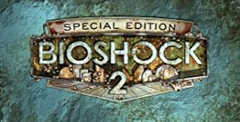 Bioshock 2
Bioshock 2
 Rage
Rage
 We Happy Few
We Happy Few
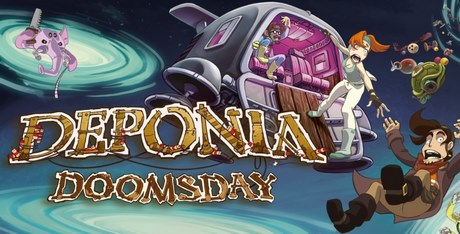 Deponia Doomsday
Deponia Doomsday
 Bioshock Infinite
Bioshock Infinite
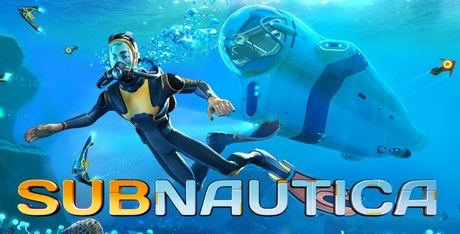 Subnautica
Subnautica
 The Witcher 2: Assassins of Kings
The Witcher 2: Assassins of Kings
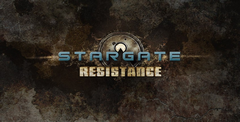 Stargate: Resistance
Stargate: Resistance
 Saints Row 2
Saints Row 2 Deus Ex: Human Revolution
Deus Ex: Human Revolution
 Sleeping Dogs
Sleeping Dogs
 Slime Rancher
Slime Rancher
 Prince of Persia: The Forgotten Sands
Prince of Persia: The Forgotten Sands
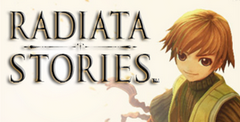 Radiata Stories
Radiata Stories
 Monster Hunter
Monster Hunter
 Lifeline
Lifeline
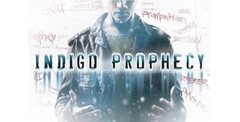 Indigo Prophecy
Indigo Prophecy Death By Degrees
Death By Degrees
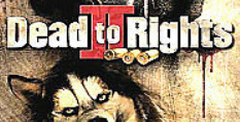 Dead to Rights II
Dead to Rights II
 25 To Life
25 To Life
 inFamous
inFamous
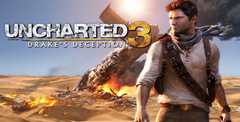 Uncharted 3: Drake's Deception
Uncharted 3: Drake's Deception
 inFamous 2
inFamous 2


